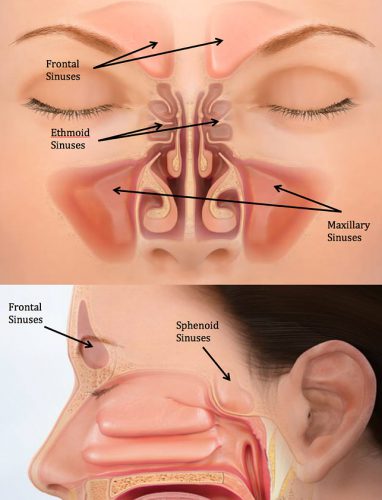The trauma service typically helps our facial surgery colleagues manage patients from time to time. Every now and again, I see their request/instructions for “sinus precautions” when patients have certain fracture patterns or undergo surgery involving sinuses. Where did these “precautions” come from? Do they really make sense?

The paranasal sinuses shown above are the most commonly injured after facial trauma. They are lined with mucosa, and like the rest of our body, colonized with bacteria. They are interconnected with each other and the nasal cavity via tiny ostia that allow for normal drainage into the nose. Facial surgeons worry that these bacteria may seep out of fractured areas into clean tissue and cause deep infections. This may occur spontaneously, and could be accelerated if the pressure in the sinuses is increased in any way.
If you do a simple internet search on “sinus precautions”, it seems like every facial surgery group in the country has a set in their patient information sheet. And they all look suspiciously similar. As if they’ve been copied from each other and over, and from the same very, very old document.
As noted above, the main issue to be avoided is increasing pressure across the sinuses. Here’s the usual list of precautions, and my comments on their utility.
- Avoid blowing your nose. This one actually makes sense. Closing the nose and mouth, pressurizing the pharynx and releasing through the nose will certainly increase sinus pressures. And there are actually reported cases of new onset cellulitis after this maneuver. True
- Avoid sneezing. Good luck on this one. Who actually does this on purpose anyway? Sneezing will certainly increase sinus pressures, but this can be minimized by avoiding trying to stifle the sneeze. True
- Do not drink through a straw. What? This causes a low pressure zone in the oropharynx so that fluids can be sipped, but the nasopharynx is isolated. If it weren’t you’d have beverages pouring out of your nose. False
- Do not smoke. Well, this is certainly a good idea for many reasons, but has little impact on nasopharyngeal pressures. If anything, it decreases them slightly on inhalation, and works the same on exhalation as breathing out without the smoke. False
- Do not blow musical instruments, balloons, … Yes, this can increase pressures. True
- Do not push or lift heavy objects. Hmm. The natural tendency is to perform a Valsalva maneuver (holding breath against a closed glottis) when doing this. In theory, this shouldn’t impact the sinuses because they are not attached to the trachea in any way. And even though it is possible to let some air escape the glottis and keep your mouth closed, it immediately exits the nose. Exhaling through the nose rapidly could increase pressures slightly. Most people don’t do this. Mostly false
- Do not bend over, keep your head above your heart, sleep with your head slightly elevated. Come on, now. Sinuses are rigid, air-filled cavities. They don’t compress. False
- Do not fly in a plane. Definitely an issue. Everybody experiences popping ears and sinuses when flying. And it’s the descent that is of most concern. The increasing air pressure during this phase of flight can push fluid and air out of the sinuses. True
- Do not spit. Okay, this goes without saying. It’s rude, but doesn’t do a thing to your sinuses. False
Bottom line: I was unable to find any seminal paper or book chapter as the source for “sinus precautions”. Most of the items on the list are bogus. But a few do actually increase sinus pressures and could result in fluid, air, and bacteria moving out of sinuses and into areas where they don’t belong. Pare down the list before you hand it to your patients.
